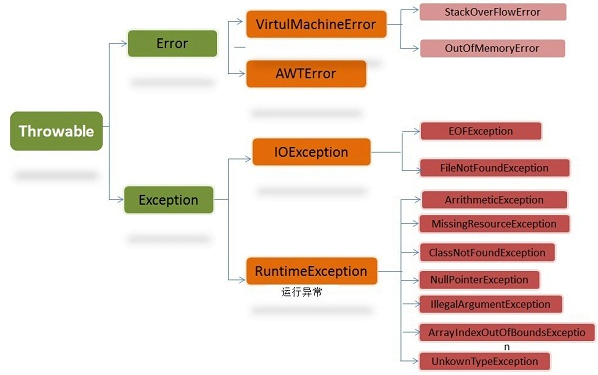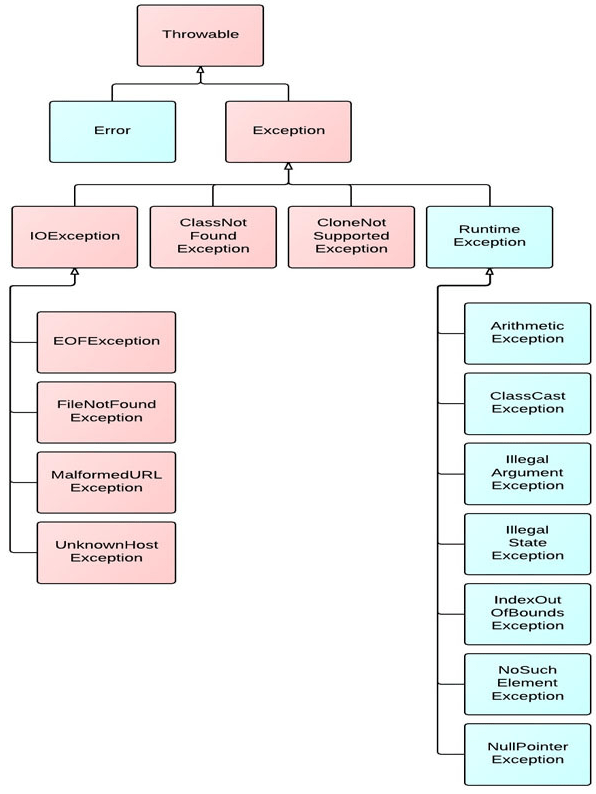概述
在Java中,所有的事件都能由类描述,Java中的异常就是由java.lang包下的异常类描述的。

1、Throwable(可抛出): 异常类的最终父类,它有两个子类,Error与Exception。
Throwable中常用方法有:
getCause():返回抛出异常的原因。如果 cause 不存在或未知,则返回 null。
getMeage():返回异常的消息信息。
printStackTrace():对象的堆栈跟踪输出至错误输出流,作为字段 System.err 的值。
2、Error(错误): 表示程序无法处理的错误,一般与程序员的执行操作无关。理论上这些错误是不允许发生的,如果发生,也不应该试图通过程序去处理,所以Error不是try-catch的处理对象,而JVM一般的处理方式是终止发生错误的线程。Error类常见子类有VirtualMachineError与AWTError。
3、VirtualMachineError(虚拟机错误): 表示虚拟机出现错误。
在Java运行时内存中,除程序计数器外的虚拟机栈、堆、方法区在请求的内存无法被满足时都会抛出OutOfMemoryError;
而如果线程请求的栈深度超出虚拟机允许的深度时,就会抛出StackOverFlowError。
4、AWTError(AWT组件出错): 这个错误并不是很常用。但是提一下AWT与Swing的区别,AWT是使用操作系统中的图形函数的抽象窗口工具,用C\C++编写,为了实现Java“一次编译,处处运行”的理念,AWT使用各个操作系统图形函数的交集,所以功能较差,但运行速度较快,适合嵌入式Java;
而Swing组件是基于AWT编写的图形界面系统,它用纯Java编写,所以必然实现了“一次编译,处处运行”,但相较于AWT运行速度较慢,适合PC使用。
5、Exception(异常): 出现原因取决于程序,所以程序也理应通过try-catch处理。
异常分为两类:可查异常与不可查异常。
可查异常:编译器要求必须处理,否则不能通过编译,使用try-catch捕获或者throws抛出。常见的可查异常有IOException(IO错误)及其子类EOFExcption(文件已结束异常)、FileNotFound(文件未找到异常)。
不可查异常(也叫运行时异常):编译期不会检查,所以在程序中可不处理,但如果发生,会在运行时抛出。所以这类异常要尽量避免!常见的不可查异常都是RuntimeException类及其子类。
1’ NullPointerException:空指针异常。 调用了不存在的对象或未经实例化或初始化的对象时会抛出,如当试图操作一个空对象(赋值为null)的属性、方法时就会抛出。
(实例化:通俗的理解就是为对象开辟空间,使其可在规定范围内被调用。注意:User u;这只是一个对象声明,并没有进行实例化或初始化。
初始化:就是把实例化后的对象中的基本数据类型字段赋默认值或设定值,为非基本类型赋值null,对于static字段只会初始化一次。)
2’ ArithmeticException:算术条件异常。 最常见的就是0作除数时会抛出。
3’ ClassNotFoundException:类未找到异常。 在通过反射Class.forName(“类名”)来获取类时,如果未找到则会抛出异常。
4’ ArrayIndexOutOfBoundsException:数组索引越界异常。 当试图操作数组的索引值为负数或大于等于数组大小时会抛出。
5’ NegativeArraySizeException:数组长度为负值异常。 一般在初始化数组大小为负值时抛出。
6’ ArrayStoreException:数组类型不匹配值异常。 例如将一个Object数组中加入一个Integer对象与一个String对象时,类型不匹配就会抛出。
7’ IllegalArgumentException:非法参数异常。 会在使用Java类库方法时传入参数值越界时抛出。
处理异常
Java中的异常处理原则:必须声明抛出异常或捕获可查异常,允许忽略Error与不可查异常。
public class TestException {
public static void main(String[] args)
throws IOException{ //抛出可查IO异常
//throw是针对对象抛出的异常,throws是针对方法抛出的异常
FileWriter fileWriter = new FileWriter("output.txt");
String str = null; //str对象未经初始化
try {
fileWriter.write(str); //尝试调用未经初始化的str对象,会抛出空指针异常
} catch (NullPointerException e) {
System.out.println("Catch NullPointerException!");
}finally{
str = "finally!";
fileWriter.write(str);
fileWriter.close();
}
}
}
执行结果:
控制台:
Catch NullPointerException!
output.txt:
finally!
1、throws意为抛出,只要出现异常,就会创建对应异常对象,然后记录异常时运行状态等异常信息,交付给运行时系统处理。抛出异常是一定执行在捕获之前的,没有抛出就不会有捕获。程序可以显式使用throws来声明抛出可查异常以通过编译。
2、try-catch-finally异常捕获语句:
try中是可能发生异常的程序段;
catch中依次编写对应的异常处理器方法,当抛出异常后,由运行时系统在栈中从当前位置开始依次回查方法,直到找到合适的异常处理方法,如果未找到,则执行finally或直接结束程序运行。
finally :无论是否捕获或处理异常,finally块里的语句都会被执行。
注意(很重要,面试常问):当在try块或catch块中遇到return语句时,finally语句块将在方法返回之前被执行。
在以下4种特殊情况下,finally块不会被执行:
1)在finally语句块中抛出了异常且未处理。
2)在前面的代码中用了System.exit()退出程序。
3)程序所在的线程死亡。
4)CPU出现异常被关闭
3、try-catch-finally的执行顺序
1’当没有异常捕获时,会跳过catch,直接执行finally块。
public class TestException {
public static void main(String[] args){
try {
System.out.println("Hello world!");
} catch (NullPointerException e) {
System.out.println("Catch NullPointerException!");
}catch (ArithmeticException e) {
System.out.println("Catch ArithmeticException!");
}catch(Exception e){
System.out.println("Catch other Exception!");
}
finally{
System.out.println("Finally!");
}
}
}
输出结果:
Hello world!
Finally!
2’ 当抛出运行时异常且没有定义相应的异常处理方法,就会由JVM抛出异常。
public class TestException {
public static void main(String[] args){
String str = null;
int a = 2, b = 0;
//调用空对象的方法,会抛出空指针异常
System.out.println(str.length());
}
}
输出结果:
Exception in thread “main” java.lang.NullPointerException
at Java面试.TestException.main(TestException.java:11)
3、当try捕获到异常,catch语句块里有处理此异常的情况:在try语句块中是按照顺序来执行的,当执行到某一条语句出现异常时,程序将跳到catch语句块,并与catch语句块逐一匹配,找到与之对应的处理程序,其他的catch语句块将不会被执行,而try语句块中,出现异常之后的语句也不会被执行,catch语句块执行完后,最后执行finally语句块后的语句。
public class TestException {
public static void main(String[] args){
String str = null;
int a = 2, b = 0;
try {
//调用空对象的方法,会抛出空指针异常
System.out.println(str.length()); //语句1
//除数为0,会抛出数学运算错误
System.out.println("a/b=" + a/b); //语句2
} catch (NullPointerException e) {
System.out.println("Catch NullPointerException!");
}catch (ArithmeticException e) {
System.out.println("Catch ArithmeticException!");
}catch(Exception e){
System.out.println("Catch other Exception!");
}
finally{
System.out.println("Finally!");
}
}
}
输出结果:
Catch NullPointerException!
Finally!
自定义一个异常类
通过继承Exception类实现。
public class TestException {
public static void main(String[] args){
String str = null;
int a = 2, b = 0;
try {
//调用空对象的方法,会抛出空指针异常
System.out.println(str.length()); //语句1
//除数为0,会抛出数学运算错误
System.out.println("a/b=" + a/b); //语句2
} catch (NullPointerException e) {
System.out.println("Catch NullPointerException!");
}catch (ArithmeticException e) {
System.out.println("Catch ArithmeticException!");
}catch(Exception e){
System.out.println("Catch other Exception!");
}
finally{
System.out.println("Finally!");
}
}
}
异常链与异常栈轨迹
public class TestException {
public static void main(String[] args){
TestException test = new TestException();
String str = null;
test.printStringMessage(str);
}
public void printStringMessage(String str){
System.out.println(str.length());
}
}
输出结果:
Exception in thread “main” java.lang.NullPointerException
at Java面试.TestException.printStringMessage(TestException.java:16)
at Java面试.TestException.main(TestException.java:12)
常规异常:有Java所定义的异常,不需要异常声明,在未被try-catch的情况下,会被默认上报到main()方法。
异常的冒泡上传机制:当一个异常对象产生了以后,其会按照调用层次(一般是方法的调用层次)进行冒泡,直到被try-catch处理,或上报至main()方法。
/
//自定义的异常类
public class MyException extends Exception{
String message; // 定义String类型变量
public MyException(String ErrorMessagr) { // 父类方法
message = ErrorMessagr;
}
public String getMessage() { // 覆盖getMessage()方法
return message;
}
}
//测试异常链、冒泡机制
public class TestException {
void firstThrow()
throws MyException { //抛出自定义异常
System.out.println("Oringinally creat a MyException and throw it out");
throw new MyException("MyException"); //真正的抛出异常处
}
void secondThrow()
throws MyException { //抛出自定义异常
firstThrow(); //调用firstThrow()
}
public TestException()
throws MyException { //构造方法,抛出自定义异常
secondThrow(); //调用secondThrow()
}
public static void main(String[] args) {
try{
//调用构造方法
TestException testException=new TestException();
}
catch(MyException e)
{
e.printStackTrace();
System.out.println("Catch a my exception!");
}
}
}
输出结果:
Oringinally creat a MyException and throw it out
Java面试.MyException: MyException
at Java面试.TestException.firstThrow(TestException.java:11)
at Java面试.TestException.secondThrow(TestException.java:16)
at Java面试.TestException.(TestException.java:20)
at Java面试.TestException.main(TestException.java:26)
Catch a my exception!
从异常栈的记录信息可以发现,与代码相对应的异常抛出机制和次序:
firstThrow()产生MyException对象->异常冒泡至调用其的secondThrow()->冒泡至调用secondThrow()的TestExceptionChain的构造方法->冒泡至printtry的main()方法。
注意到:异常对象一直被抛出,直至在printtry的mian()方法中被try-catch捕获!
在补上一张异常类的继承图

参考
Java异常的深入研究与分析
JAVA基础——异常详解
Java必知必会:异常机制详解 |强烈推荐,写的非常棒!
发表回复